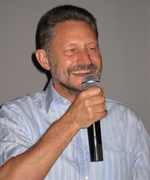 |
Interview with Freddy
Dumortier
by Bernd Krauskopf, University of Bristol, UK |
|
Freddy
Dumortier speaks at the dinner of his 60th birthday
conference.
|
|
Freddy Dumortier is Professor at the Universiteit
Hasselt in Belgium. He is well known for his work in
bifurcation theory, blow-up techniques and slow-fast systems. His 60th
birthday was celebrated in April 2007 in Hasselt and Brussels with the
conference Dynamics in Perturbations. Bernd Krauskopf used
this opportunity to talk to him at the Belgian Academy of Sciences Building about his
views on the field of dynamical systems.
|
BK: How did you get involved in dynamical
systems?
FD: After my Master's research in 1969 on
questions of differential topology I was looking for a suitable topic
for PhD research. In 1970 I went to a conference in Amsterdam on
manifolds to meet and talk to Nico
|
|
 |
| The Belgian Academy of Sciences
Building. |
|
Kuipers, whose work I knew through his publications. He advised me to
switch my interest to the new and emerging field of dynamical systems
and to work with his former student
Floris Takens. So I started PhD
work on singularities of planar vector fields as Floris's first PhD
student.
|
What was that like?
During my PhD time I was in Brussels, funded by
the Fonds voor Wetenschappelijk Onderzoek, and officially supervised
by Professor Wuyts. So in effect, I did a long-distance PhD with
regular meetings, many of them at the train stations, and through
letters when Floris was away for longer periods of time. I really
enjoyed the freedom this arrangement gave me and the leadership that
Floris provided. It allowed me to find out things all by myself.
What about meeting other
researchers?
In summer 1972 I went to a summer school at ICTP in
Trieste organised by Jim Eells and Christopher Zeeman. It was a
stimulating two months of courses and presentations. There I met a
young Brazilian mathematician, Jorge Sotomayor, from the Instituto Nacional de
Matemática Pura e Aplicada (IMPA). While we did not work
closely together initially, I later published a number of papers with
him.
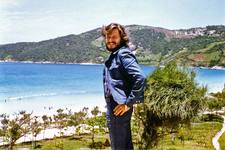 |
|
After my
promotion in 1973 I spent a whole year at
IMPA. In total I must have spent at least three full years of my life
there. The atmosphere at IMPA was very open and vibrant with many
visitors. Jacob Palis was a main
driving force and I took part in his seminar and other seminars. IMPA
is also where I met my long-term close collaborator Robert Roussarie
for the first time in 1976. He had made use in his work of results in
my thesis and we started working together straight away on a question
suggested by Jacob Palis. Today Robert and I have more than twenty
joint papers and are continuing to work together.
|
| In Brazil in 1974. |
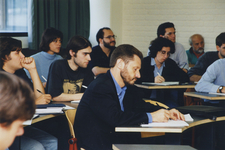 |
| Taking notes in Diepenbeek in
1998. |
How do you see yourself as a
mathematician?
I am a pure mathematician in the sense that I
want to get to the bottom of things by constructing rigorous proofs. I
do not feel the urge to delve into an application area, but rather
enjoy sorting out the technical issues that are needed to make a proof
work. At the same time, I have the hope that my results fall within
`Applicable Mathematics'.
Do you have an example of the
latter?
|
With Robert
Roussarie and Jorge Sotomayor I worked on the codimension-three
unfoldings that arise at degenerate
cases of the Bogdanov-Takens bifurcation. In fact, already in 1975 I
wrote a letter to Vladimir Arnold asking him to send me the
publications of Professor Bogdanov and inquiring whether the
generalization to higher codimension had been done. Arnold informed
me that, first, Bogdanov is not a professor and, second, the
codimension-three problem had been solved. Therefore, I stopped
working on this problem. However, it turned out only much later that
the codimension-three problem was actually still unresolved, and I
picked it up again with Robert and Soto.
|
|
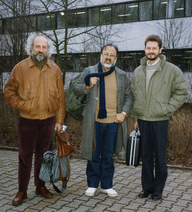 |
| Robert Roussarie, Jorge
Sotomayor and Freddy Dumortier at Hasselt University in
1990. |
|
After they appeared as Springer
Lecture Notes in Mathematics, our results have been applied quite
quickly by other colleagues in fields as diverse as laser physics and
ecology. I am confident that my more recent work on singular
perturbations will also lead to insights and results that are
applicable to models arising in different scientific
domains.
|
How do you see the
relationship between pure and applied mathematics more
widely?
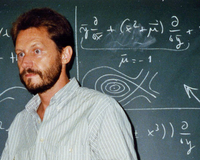 |
|
To me
both aspects seem essential to
mathematics and they should continue to influence each other
closely. There really is a need for good research ranging from direct
applications, as done by engineers, for example, all the way to work
that deals with the foundations of mathematical thinking
itself. Policy makers should better be convinced of this point of view
as well. However, present funding, certainly in Europe, is primarily
directed towards subjects
|
| Presenting an unfolding in
1990. |
|
that have a certain market
value, such as cancer or telecommunications research. This is not a
bad thing as such, but it creates a need to justify fundamental
research, which is
no longer seen as useful in its own right. A lot of mathematics is of
course quite fundamental. While mathematics is perceived as
inexpensive --- and the more so the more theoretical it is ---
funders nevertheless expect some sort of return after a few
years. This easily creates the message that pure mathematics is not
essential. Yet I believe that most countries ought to invest more in
fundamental research.
|
|
What about funding opportunities for the next
generation of mathematicians?
In the last years a lot of new positions for
PhD research have been created, but generally the number of permanent
faculty to supervise them has stayed the same or has even decreased.
Not only does this increase the work load of permanent staff, but it
also means that there are insufficient opportunities for young
researchers after their PhD. Certainly in Belgium there is a shortage
of postdoctoral positions with a perspective of a permanent academic
career.
|
|
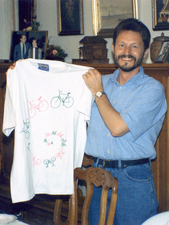 |
| Freddy with the `Finite
bicyclicity shirt' that he received as a thank-you from the students
on the 1992 spring course on dynamical systems that he organised in
Hasselt. |
How do you see the role of
dynamical systems research in society.
I think that society is only beginning to see
how important mathematics is in our daily lives. In particular,
statistics is now seen as crucial for any sort of major decision, and
sometimes this is taken to absurd extremes. Nevertheless --- and
this is positive --- the feeling is that statistics is a must, and
this attracts people to become statisticians. The field of dynamical
systems, on the other hand, is much less visible in society. I think
that we are simply not selling ourselves well enough.
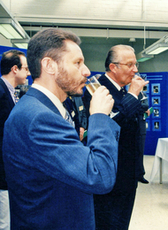 |
|
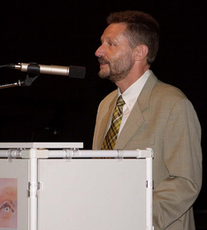 |
| With King Albert II at Hasselt
University in 2003. |
Opening speech of
Equadiff2003
in Hasselt. |
What do you think needs to be
done?
We should really promote more widely the
usefulness of mathematics. Indeed, mathematics is applied in very
useful things every day and on a large scale, from aeroplanes to
mobile phones, but this is often not so well known. I do not have a
simple solution, but believe that we should all do more lobbying and
public awareness work. For example, I was involved in media activities
around the World Mathematics Year 2000. I also try to use all
opportunities to get in touch with the press. Some journalists know
that they can call me when they have a mathematical question. Personal
contacts count and they take a long time to establish. Of course,
professional societies such as SIAM are already playing an important
role in popularizing mathematics, but we could always do more.